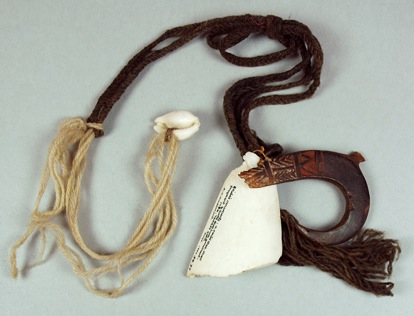Turtle-shell pendant
Meriam people, Torres Strait Islands, Australia, 19th century
 Donated by Alfred Cort Haddon in 1889; 1889.34.37The Torres Strait islanders have a rich tradition of personal adornment including various necklaces and waist bands made from strung olive husks, dogs' teeth and snail shells. This ornament from the Eastern islands consists of a cowrie shell, larger trochus-shell fragment, and a pedant ornament in the shape of a fishhook made from turtle-shell (sabagorar). They are strung and tasselled with imported European wool.
Donated by Alfred Cort Haddon in 1889; 1889.34.37The Torres Strait islanders have a rich tradition of personal adornment including various necklaces and waist bands made from strung olive husks, dogs' teeth and snail shells. This ornament from the Eastern islands consists of a cowrie shell, larger trochus-shell fragment, and a pedant ornament in the shape of a fishhook made from turtle-shell (sabagorar). They are strung and tasselled with imported European wool.
Charles Hedley went to Murray Island in 1907 to collect items for the Australian Museum, inspired by the earlier expeditions to the island made by Professor Alfred Cort Haddon (who collected and donated this object to the Pitt Rivers Museum). According to Hedley, sabagorar fishhook ornaments could be worn on the front or the back, but only by married women. The hook was usually incised with geometric designs infilled with white and red ochre, and several may have been worn together. The triangular piece of white shell was often worn as a sign of engagement and later incorporated in to the fishhook pendant upon marriage.
On the Torres Straits, it was women who initiated courtship. A woman would express her interest in a young man by sending him a small gift – usually through his sister – and might wear a love charm hidden in her clothing in his presence so as to infatuate him. Should the boy be interested, the girl's parents would eventually involve themselves in negotiations with the boy's family about the exchange of goods. Presents and food were offered but the man's family often provided more valuable gifts such as a canoe or shell ornaments. Upon the settlement of the exchange and a community celebration, the bride was simply brought to the camp of her new husband, where she would build a fire and begins the responsibilities of wifehood. It was generally only the most successful male leaders who were able to afford the multiple bride-prices that polygamous marriages required, but the practice died out in any case with the introduction of Christianity by the London Missionary Society in 1871.
